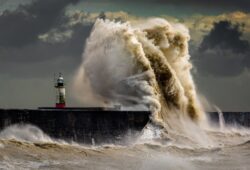UK storms are usually named by the Met Office – but Otto was different (Picture: Getty Images)
Major storms, hurricanes, cyclones and weather events tend to be given their own name.
Many will recall the nationwide devastation caused by Storm Eunice last year, including the roof being torn off the O2 Arena.
The UK is currently bracing for Storm Otto to hit our shores.
But why do storms have names, and what will the rest of the storms in 2023 be called?
Here’s all you need to know.
What are the 2023 storm names?
To view this video please enable JavaScript, and consider upgrading to a web
browser that
supports HTML5
video
Full list of UK and Ireland storm names for 2022/23
The UK and Ireland storm names for the 2022/23 storm season are as follows:
Antoni
Betty
Cillian
Daisy
Elliot
Fleur
Glen
Hendrika
Ide
Johanna
Khalid
Loes
Mark
Nelly
Owain
Priya
Ruadhan
Sam
Tobias
Val
Wouter
Storm Otto is the first official UK storm of the 2022/23 season – but it isn’t called ‘Antoni’ because the Danish Meteorological Institute (DMI) had the honour of naming it as that country is expected to be hit by more severe weather.
Why do storms have names?
It is simply to help make people more aware of severe incoming weather.
The idea is that when you hear a storm named you’ll know to expect heavy rain, dangerous winds or snowfall.
Storm Dudley caused plenty of destruction in February 2022 (Picture: Elizabeth Howard/Twitter/PA)
The Met Office and the Irish equivalent Met Éireann decided to begin naming storms after a survey revealed people became more aware of extreme weather warnings once the storm was given a name.
In response to the results, a list of names was drawn up from suggestions from the public which has given us the likes of Storm Abigail and Storm Doris in recent years.
Many will remember February 2022’s destructive Storm Eunice, which quickly followed the damage caused by Storm Dudley.
However, naming storms is not a new phenomenon as the US National Hurricane Centre has named tropical storms since 1953. This makes it easier to refer to Atlantic tropical storms when tracking them and ensures the public will always know exactly what storm is on its way.
Since the regions of the mid-Atlantic are so often plagued with tropical storms that evolve into hurricanes, it makes sense to distinguish between them – with the US and the Caribbean suffering severe damages from the likes of Hurricane Harvey, Hurricane Irma, and Hurricane Maria in recent years.
Arwen was the first storm of the 2021/22 cycle (Picture: Jason Brown/SOPA Images/LightRocket via Getty Images)
When is a storm named?
A name is given to a storm when it is expected to reach an amber or a red warning level.
The warnings are issued by the Met Office National Severe Weather Warning Service when extreme weather conditions like rain, wind, snow, ice, fog and high temperatures are forecasted.
Red, amber, yellow or green weather warnings are based on guidance from the National Severe Weather Warning Service, and are decided by a combination of both the impact the weather may have and the likelihood of those impacts happening.
More: UK weather
Once the storm meets the criteria for being named, either Met Éireann or the Met Office will publicly name the storm, adhering to the formulated list.
How are the names chosen?
The Met Office publishes a list of storm names ahead of each winter season. The list runs from early September to late August the following year.
The Met Office collaborates with Met Éireann and the Royal Netherlands Meteorological Institute (KNMI) to name storms based on suggestions sent in by the public.
Send in your own suggestions by emailing [email protected].
Why are storms never given Q, U, X, Y or Z names?
Looking at the above list, you’ll note no UK and Ireland storms begin with the letters, Q, U, X, Y or Z.
Hurricanes are named in the US – pictured is the aftermath of Sandy in New Jersey – and keep to their naming convention for consistency (Picture: Mario Tama/Getty Images)
All three of the aforementioned organisations behind storm naming address this when announcing new names, stating the decision is to stay ‘in line with the US National Hurricane Centre naming convention’.
It also ‘maintains consistency for official storm naming in the North Atlantic’.
According to AccuWeather’s senior meteorologist, Dan Pydynowski, other parts of the world do use some of these letters when naming their tropical storms or cyclones.
He explained: ‘The East Pacific uses X, Y and Z, while the Atlantic does not… the East Pacific averages more named storms per year. Thus, more names are needed in an average year and there is a better chance [of reaching] the end of the list.’
MORE : New Zealand declares third national emergency in history after cyclone hits
MORE : When is the first day of spring 2023 and what is the spring equinox?
Follow Metro across our social channels, on Facebook, Twitter and Instagram
Share your views in the comments below
Previous storms include Arwen, Dudley, Eunice and Franklin.




